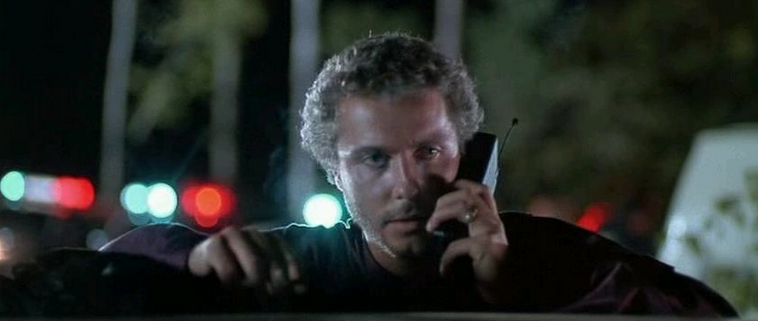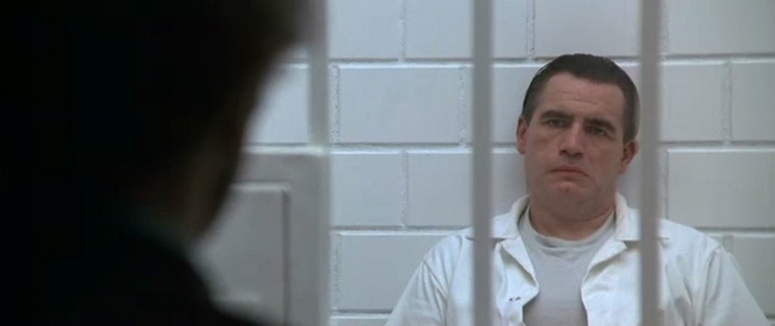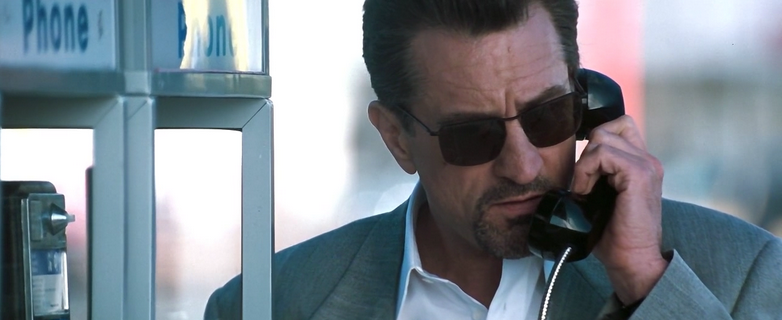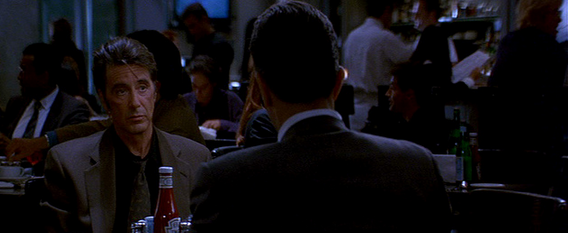The October Hallowe’en season of RBC’s Weekend Movie Recommendations begins. Keith and I will be devoting this month to writing about terrific and ghoulish films. And what better ghoul is there to introduce the theme than the most horrific of them all, the notorious Dr. Hannibal Lecktor? It’s Michael Mann’s 1986 film adaptation of Thomas Harris’ novel Red Dragon: Manhunter.
A brutal serial killer has a pattern of breaking into his victims’ homes and murdering the entire family as part of a series of grotesque and inexplicable rituals. In addition to shattering every mirror in the victims’ home and placing the fragments in the corpses’ eye sockets, he also leaves behind bite marks that have earned him the nickname ‘The Tooth Fairy.’ This strange M.O. has compelled FBI agent Crawford (played by the ever-impeccably mustachioed Dennis Farina) to lure retired criminal profiler Will Graham (played by William Petersen of CSI fame) back to help solve That One Case.
Graham’s the best at what he does, but his work comes at a price. His unusual capacity to inhabit the mind of the killers he hunts has brought him within harm’s way before, in the case that forced him into early retirement and that haunts him still. Indeed, the specter of one Hannibal Lecktor (played by Brian Cox) looms large, and when Graham is stumped in his search for the Tooth Fairy he is forced to consult Lecktor for advice on how the killer thinks. It is a strange and deeply affecting dynamic, wherein Graham empowers Lecktor to be both his own tutor, while at the same time (unbeknownst to Graham) Lecktor is guiding the Tooth Fairy as well.
This isn’t the first film I’ve reviewed by Mann here at RBC (see my review of Heat here), and this shares two important similarities with that later film: in addition to showing Mann’s idiosyncratic flair for (especially visual) style, both films play an unusual game with the audience’s sympathies. The conceit of that game is identical in both Heat and in Manhunter, as the villain and the antihero both complete one another in perfectly obvious ways. However, while the protagonists in Heat reach a rapprochement through their mutual admiration and dedication to one another’s craft, in Manhunter the relationship between Graham and Lecktor is unambiguously contemptuous: Graham freely tells Lecktor that he believes him to be insane, and in return Lecktor knowingly induces an acute panic attack that leaves Graham desperate for fresh air. And the symmetry between Graham and the Tooth Fairy is conspicuous, too: as Graham’s (willful) descent into the mind of a killer distances him further from his family, the Tooth Fairy’s (uncontrollable and reluctant) violence brings him closer to his first intimate connection with another human being. Therefore, while Graham and his prey are completely antagonistic towards one another, nonetheless they are manifestly incomplete without one another.
Mann’s preoccupation with the characters’ duality shows up throughout the film in the vivid use of color and carefully considered camera-work that he obviously honed while working on Miami Vice. For some, Mann’s heavy reliance on over-saturated colors (and particularly his use of pastels) may be wearisome. But when compared to the visually drab interpretations of Harris’ sequel Silence of the Lambs by Jonathan Demme or Brett Ratner’s re-make of Manhunter using the original title Red Dragon (both stupendous films in their own right but for different reasons), Mann’s gimmicky style takes on particular value. After all, serial killers with fantastically gruesome rituals of the kind that appear in a Harris novel are hardly meant to be under-stated in the first place. In that vein, Mann’s stylization makes sense as a pretty good visual expression of the chaos of the world he’s constructing. Instead of showing you the killer at work, as do Demme and Ratner, Mann instead draws you into the production of death as though by way of a carefully constructed installation exhibit that you explore after the damage is already done.
Which brings me to the performances. Despite the fact that it appears Petersen showed up for work the day after having undergone a frontal lobotomy, he actually works surprisingly well in the tortured role of Will Graham. This, too, might be related to Mann’s stylization: Petersen’s vapid stares help to ensure that the viewer’s eyes aren’t over-loaded with stimuli on the screen, in much the same way I described Kevin Costner’s subdued delivery as oddly appropriate given the bombastic scenery in Dances with Wolves (review here). Brian Cox is a superb Lecktor, and that opinion stands even after having seen what Hopkins did with the role. He is frightening, compelling, and one can’t help but hope for more screen time with him to indulge the fascination he instills. For his part, Tom Noonan is a commanding Tooth Fairy. He reputedly refused even to introduce himself to other members of the cast until they shot scenes together, as he preferred instead to seclude himself privately and silently in his trailer, in the dark, between takes. Ghoulish indeed.
Unlike Mann’s other films, the denouement of Manhunter isn’t as high-octane as is his wont (as in, for example, Last of the Mohicans or The Kingdom). But the fun in this film is to be had elsewhere, as the main payoff is in the taut chase scenes – even something as banal as a handwritten letter becomes the focus of a superbly-executed mind-game pitting Lecktor and the Tooth Fairy against Graham and the FBI.



